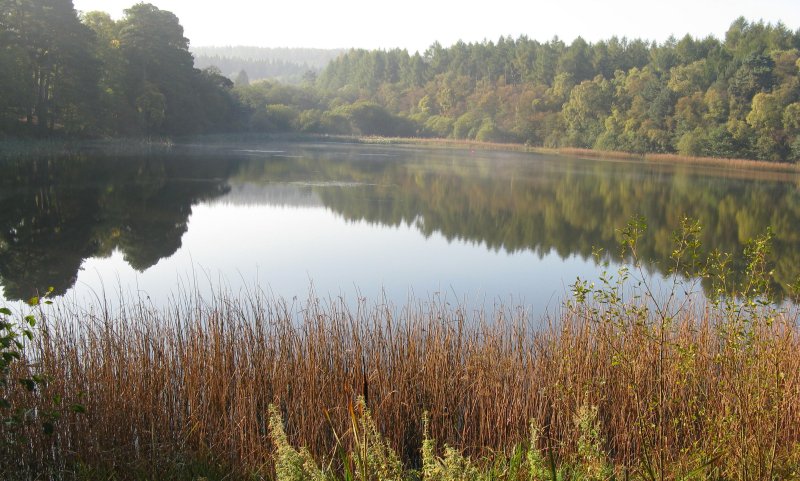
Back to the Index page
led by Rhona Sutherland. Notes by Gill Smith
[Species lists below]

A dozen members and guests met on a particularly fine autumn morning by the bottom lake in Gilling Woods. We were lucky to have not only Rhona to lead the walk but also Melanie Earle, and Alan Braddock, the President of the Mid-Yorkshire Fungus Group – so we had plenty of expertise. There were still a few streamers of morning mist over the water when we arrived, but it soon cleared and we had warm sun for the rest of the day.
We walked (very slowly) round the lake, stopping to investigate all kinds of fungi: brackets on trees and fallen logs, boletes including some fine Brown Birch Boletes Leccinium scaber, different genera of gilled mushrooms, coral-like Calocera growths and many more. There was an abundance of tiny, delicate forms which all looked very similar to the untrained eye, but Rhona, Alan and Melanie id’d most of them straight away, at least to genus level. However, even they had to take some specimens home for a final determination using detailed keys, microscopes and various chemicals: identifying fungi is a very technical business, at least in part because there are so many species, not all of which are included in the normal field guides. We did not manage to see any of the curious twisted Helvellas, or Earthstars on the walk around the lake, although I did see both later in the day closer to Yearsley.
As a rank amateur I’m afraid I have simply included the pictures below on aesthetic merit! As there wasn't much light under the trees despite the sunshine I experimented with a small tripod to hold my camera still. This caused much amusement in the group – but I am pleased with the results. Fungi come in such a great variety of shapes, sizes and colours that there is always something beautiful to see. I was particularly taken with the earthball with its textured surface (the spores form inside in a black mass).

Mini-tripod to hold the camera still in the low light conditions under the trees. This is an emerging Amanita fulva - the resulting shot is shown (cropped) on the right. |
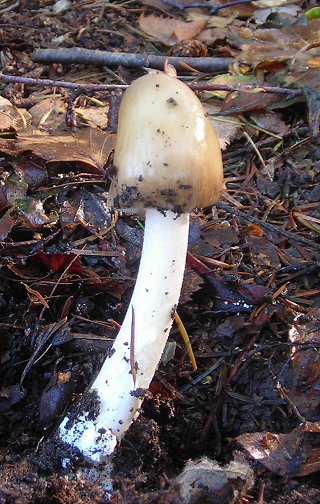
|
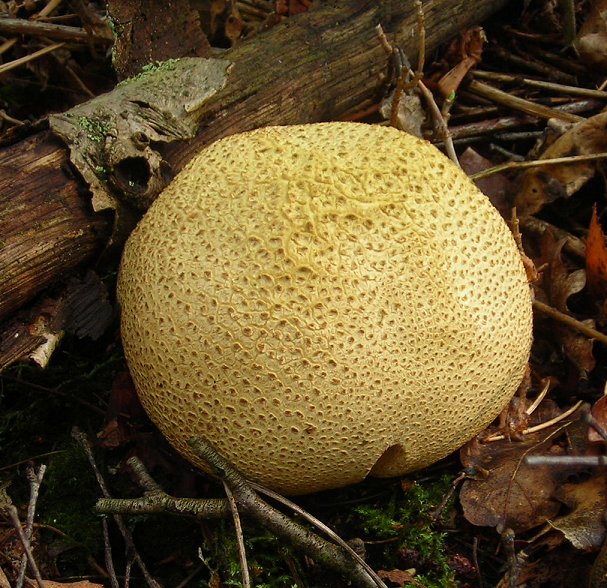
Common Earthball Scleroderma citrinum
Once the air had warmed up the dragonflies started to wake up and become active. Keith managed to catch this stunning male Migrant Hawker Aeshna mixta so we could have a really close look at it. Although the colours are bright and clear, this specimen shows damage to the wings, which is common this late in the season. The picture was taken just before he flew off again back over the lake to catch more insects. There were also Southern Hawkers, Brown Hawkers and several Common Darters including a pair in tandem, looking for somewhere for the female to lay her eggs in amongst the reedmace. We also spotted red admiral and speckled wood butterflies nectaring on ivy flowers in a sheltered, warm corner where there were also numerous other insects including hoverflies: ivy is a very important nectar source for many insects including honeybees at this time of year when not many other flowers are available. A little later I also saw a peacock butterfly basking on a branch.
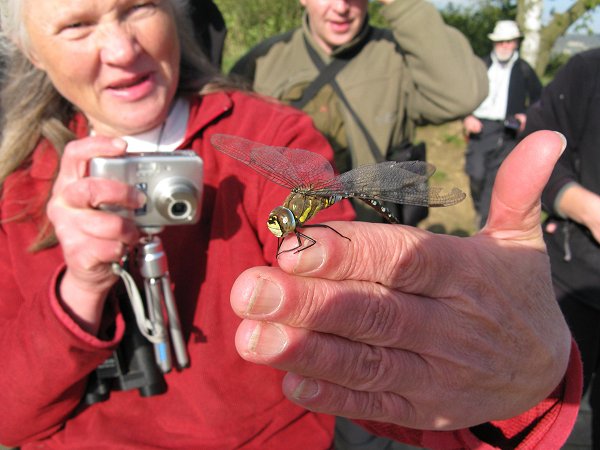
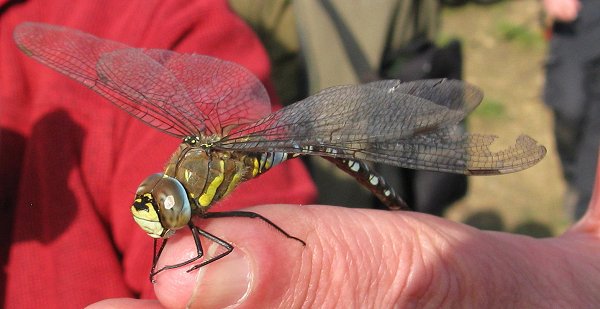
Some of the more interesting fungi were brackets on trees, including the uncommon Alder bracket Mensularia radiata near the outfall from the lake, Plicatura crispa which grows on wet twigs and has pleats or folds underneath rather than gills or pores, and the colourful Trametes versicolor. Others such as the Common Earthball above and this little Peziza badia (an Ascomycete which has its spores on the upper surface) grow on the ground. Of course the visible part of a fungus is just the fruiting body, and the main “body” of the organism as a far-reaching mycelium in the substrate which can be the leaf litter or dead wood amongst other things.
We also saw a fine toad in the damp leaf litter down by the lake.
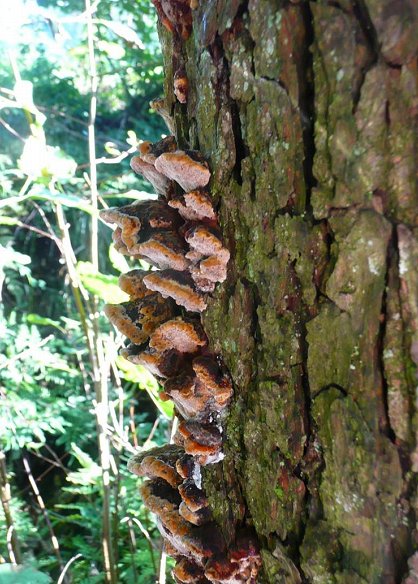
Alder bracket Mensularia radiata
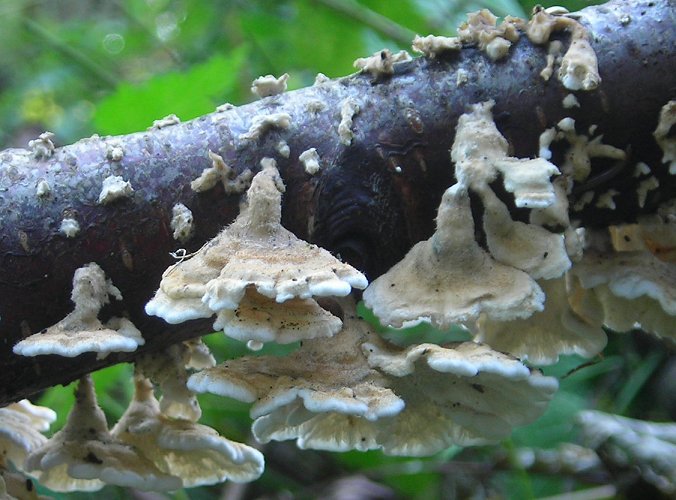
Plicatura crispa
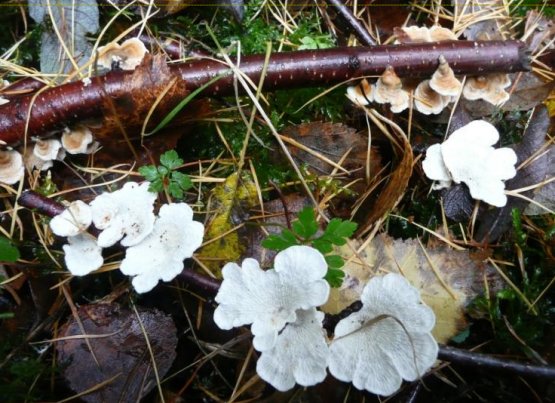
Plicatura crispa (underside)
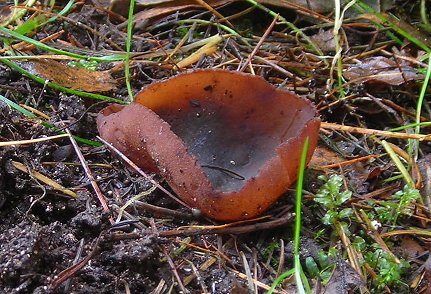
The cup fungus Peziza badia (above) and the yellow coral fungus Calocera viscosa (right) |
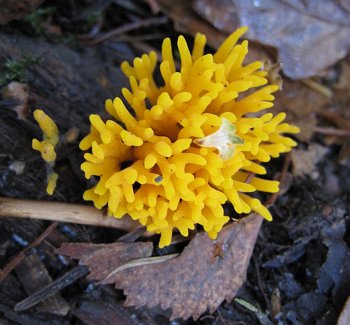
|
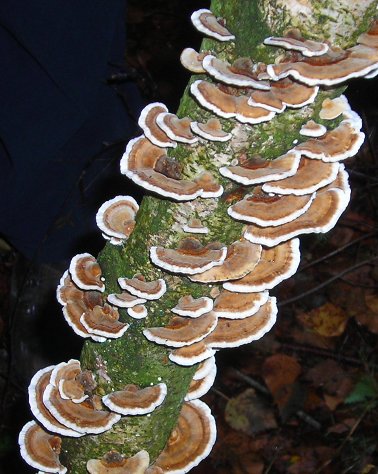
The colourful bracket fungus Turkey tail Trametes versicolor (above) and Brown Birch Boletes Leccinum scaber (right) |
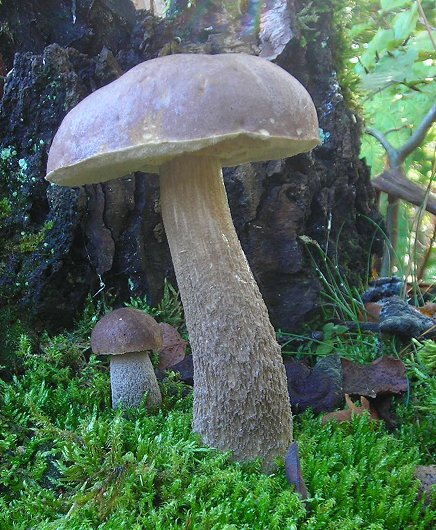
|
We heard plenty of birds up in the trees, but they were surprisingly hard to spot. I’m always surprised by how well even sizeable flocks of small birds can make themselves invisible. Thanks to Keith for the bird and insect lists.
Kingfisher
Moorhen
Fieldfare
Redwing
Siskin
Lesser Redpoll
Crossbill
Treecreeper
Greater Spotted Woodpecker
Nuthatch
Marsh Tit
Blue Tit
Coal Tit
Long-tailed Tit
Great Tit
Wren
Dunnock
Goldcrest
Buzzard
Wood Pigeon
Chaffinch
Goldfinch
Dragonflies
Migrant Hawker
Southern Hawker
Brown Hawker
Common Darter
Note: this is a draft list – more to follow.
| Latin Name | English Name |
| Amanita citrina | False Deathcap |
| Amanita excelsa var spissa | Grey Spotted Amanita |
| Amanita fulva | Tawny Grisette |
| Amanita muscaria | Fly Agaric |
| Amanita rubescens | Blusher |
| Calocera cornea | Small Stagshorn |
| Calocera pallidospathulata | Pale Stagshorn |
| Calocera viscosa | Yellow Stagshorn |
| Clitocybe nebularis | Clouded Funnel |
| Collybia butyracea | Butter Cap |
| Collybia confluens | Clustered Toughshank |
| Collybia maculata | Spotted Toughshank |
| Collybia peronata | Wood Woollyfoot |
| Cortinarius hemitrichus | Frosty Webcap |
| Crepidotus variabilis | Variable Oysterling |
| Daedaleopsis confragosa | Blushing Bracket |
| Fomes fomentarius | Hoof Fungus / Tinder Bracket |
| Helvella crispa | White Saddle |
| Heterobasidion annosum | Root Rot |
| Hypholoma fasciculare | Sulphur Tuft |
| Laccaria amethystina | Amethyst Deceiver |
| Laccaria laccata | Deceiver |
| Lactarius blennius | Beech Milkcap |
| Lactarius glyciosmus | Coconut Milkcap |
| Lactarius torminosus | Woolly Milkcap |
| Leccinum scabrum | Brown Birch Bolete |
| Leccinum variicolor | Mottled Bolete |
| Mensularia radiata | Alder Bracket |
| Mycena epipterygia | Yellowleg Bonnet |
| Mycena pura | Lilac Bonnet |
| Nectria cinnabarina | Coral Spot |
| Peziza badia | Bay Cup |
| Piptoporus betulinus | Birch Polypore / Razorstrop Fungus |
| Plicatura crispa | |
| Rickenella fibula | Orange Mosscap |
| Russula cyanoxantha | Charcoal Burner |
| Russula ochroleuca | Ochre Brittlegill |
| Scleroderma citrinum | Common Earthball |
| Stereum ochraceoflavum | |
| Suillus viscidus | Sticky Bolete |
| Trametes versicolor | Turkeytail |
| Tremella mesenterica | Yellow Brain |
| Xylaria hypoxylon | Candlesnuff Fungus |
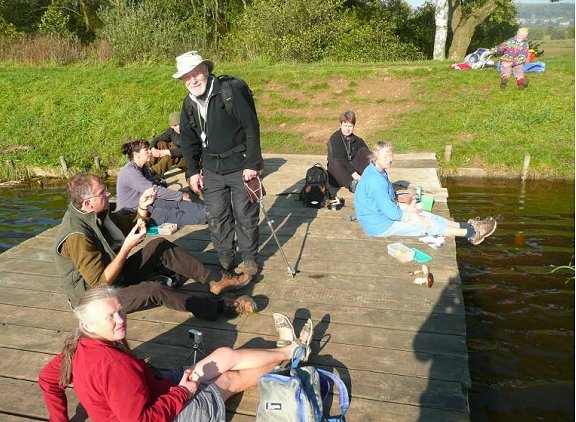
Lunch by the lake
| Text © Ryedale Natural History Society 2011; photos © Gill Smith, Keith Gittens, Tom Sutherland and Jayne Smyth | Back to the Home page |